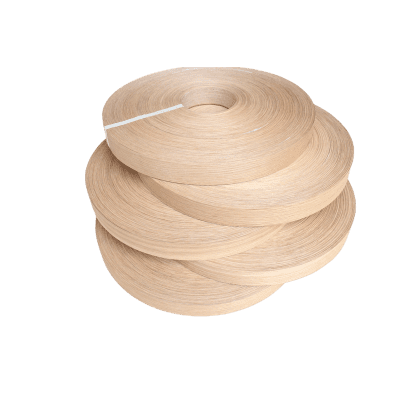Veneer edge tape, also known as edge banding tape or veneer edge banding, is a thin strip of real wood veneer that is used to cover and finish the exposed edges of furniture or woodworking projects. It provides a clean and seamless appearance to the edges of substrates like particleboard, MDF (medium-density fiberboard), or plywood. Veneer edge tape is an alternative to solid wood edging and is commonly used for its versatility and cost-effectiveness.
Here are some key characteristics of veneer edge tape:
1. Material:
- Wood Veneer: Veneer edge tape is made from real wood veneer, which is a thin layer of wood sliced from a log. This allows the tape to mimic the appearance of solid wood.
2. Thickness:
- Thin Profile: Veneer edge tape is typically thin, with thicknesses ranging from around 0.6mm to 2mm. The thin profile makes it flexible and easy to apply to curved or contoured edges.
3. Backing Material:
- Paper or Fleece Backing: To enhance flexibility and durability, the wood veneer is often backed with paper or fleece. This backing provides support during application and helps prevent the veneer from cracking.
4. Adhesive:
- Pre-Glued or Peel-and-Stick: Veneer edge tape is often available pre-glued, meaning it has adhesive applied to the back that is activated with heat during application. Some variations may also come with a peel-and-stick adhesive for easier application.
5. Variety of Wood Species:
- Various Wood Options: Veneer edge tape is available in a variety of wood species, allowing for matching or contrasting with the surface material. Common wood species include oak, maple, cherry, and others.
6. Application:
- Covering Edges: The primary purpose of veneer edge tape is to cover and protect the exposed edges of substrates, providing a finished and cohesive look to furniture and cabinetry.
7. Versatility:
- Flexible Usage: Veneer edge tape is versatile and can be used in various applications, from furniture and cabinets to shelving and other woodworking projects.
8. Finishing:
- Sanding and Staining: After application, the edges can be sanded to achieve a smooth finish. The veneer can also be stained or finished to match the overall appearance of the project.

Application Steps:
- Prepare the Substrate: Ensure that the substrate’s edge is clean, smooth, and free from debris.
- Cut the Veneer Edge Tape: Cut the veneer edge tape slightly longer than the substrate’s edge, leaving a small overhang.
- Apply Heat (if pre-glued): If the veneer edge tape is pre-glued, use a household iron or a specialized edge banding machine to apply heat, activating the adhesive.
- Position and Press: Align the veneer edge tape with the substrate’s edge and press it firmly into place. Use a roller or a wooden block to ensure even pressure.
- Trim Excess: Once the adhesive has set, trim the excess veneer edge tape using a utility knife or an edge banding trimmer.
- Optional: Sand and Finish: Sand the edges for a smooth finish. If desired, apply stain or finish to match the appearance of the project.
Veneer edge tape is a popular choice in woodworking for achieving a wood-like appearance on the edges of furniture and cabinetry while offering practical benefits such as flexibility and cost-effectiveness.

